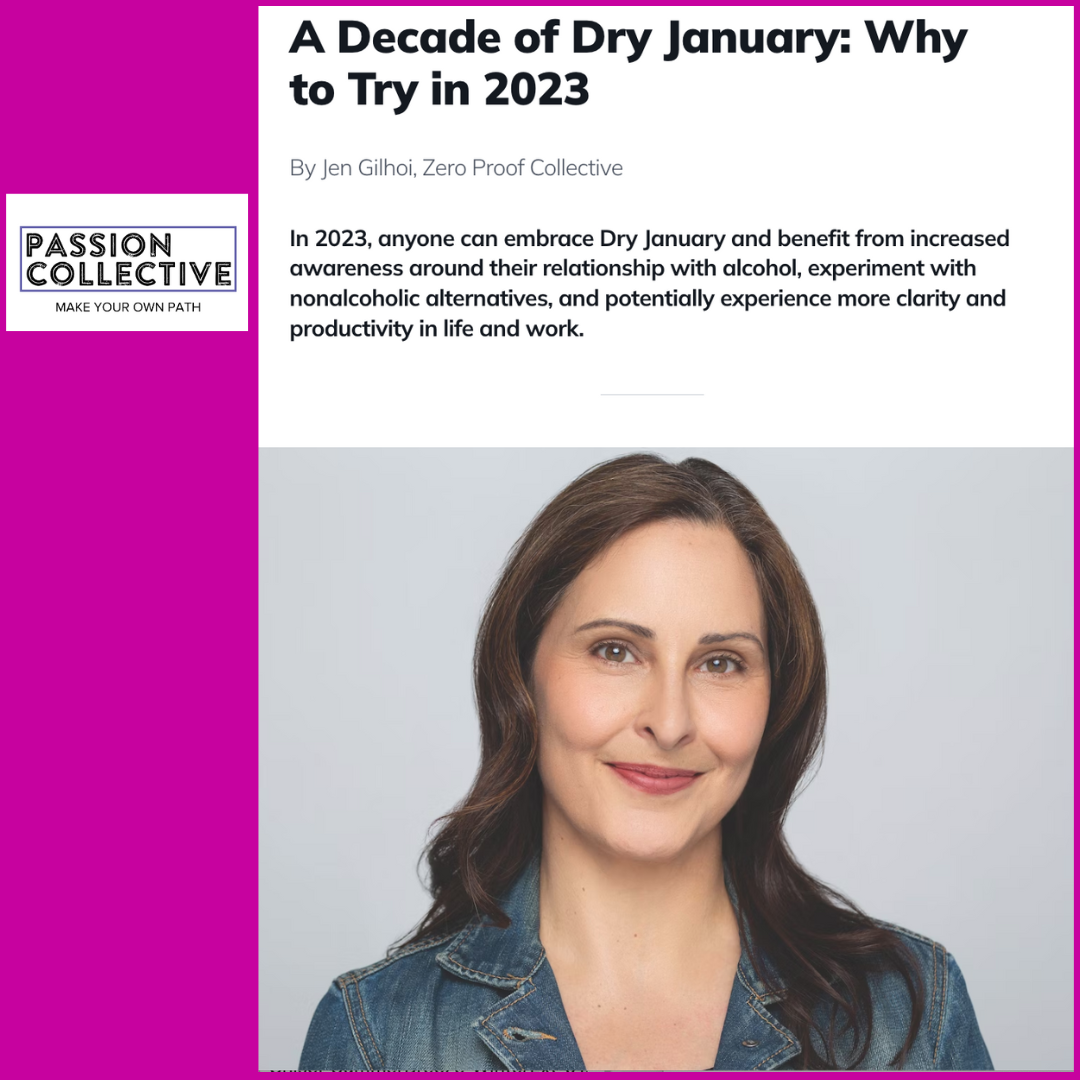A Decade of Dry January: Why to Try in 2023
This article came about through a conversation with Laura Best of the Passion Collective and appears in the Passion Collective’s OnDemand content. I’m also sharing it here with this in mind: In 2023, anyone can embrace Dry January and benefit from increased awareness around their relationship with alcohol, experiment with nonalcoholic alternatives, and potentially experience more clarity and productivity in life and work.
January 2023 marks one decade of the practice of Dry January. While Dry January originated in the United Kingdom in 2013, when the nonprofit Alcohol Change UK started a campaign to raise money for alcohol abuse and treatment, it has morphed into a global phenomenon, with people throughout Europe and the United States participating. The joiners have grown year over year with recent stats showing that 77% of those who’ve done it in the past, will do so again this year. That’s a high return rate! High enough that if you haven’t yet accepted the challenge, aren’t you the least bit curious as to what people discover over 31 days that’s so life altering?
As someone who’s amassed 3078 alcohol-free days (as of Jan 1, 2023), I’m happy to share some personal insight and anecdotal observations from participation in Dry January Facebook groups and conversations. In full disclosure, I did not get sober by way of Dry January. In Dry January’s infancy in 2013 and 2014, I’m sure I didn’t know of it over here in the U.S. If I did, I likely would have shuttered myself from the thought. Assumed it another ridiculous challenge or promise to abstain from alcohol that would frustratingly go unkept. The most time I could string together was two weeks.
My sobriety wasn’t conveniently timed with a month, rather a deep, alarming wake-up call that sobriety was wholly necessary at an inconvenient moment in late July 2014. I’m what I call sober necessary (to some groups I’ve said recovering alcoholic) and exactly the demographic the first Dry January on the books was created for.
Today in 2023, I love that Dry January has evolved as accessible for anyone. Notably in 2018, when Ruby Warrington coined the sober curious movement, we saw an increase of people joining in the January abstinence and testing the sober waters. And with the rise of nonalcoholic options in bars, restaurants, and social spaces, the sober curious or anyone doing Dry January doesn’t have to stay home for 31 days – an isolating experience that can further compound the desire to drink to numb our discomfort. This is an important shift because it allows Dry January participants to integrate non-drinking into their social life and lifestyle, thereby creating something much more sustainable that has potential to go beyond 31 days.
I’ve seen it happen and it’s just the coolest! I’m actually in awe of the sober people I meet now who more frequently came about their current alcohol-free (AF) or moderate alcohol consumption lifestyle via Dry January (or Dry July, Sober October). Might I have found my way to sobriety in my twenties if this was a path? At age 50, it’s a question I will remain forever curious about.
Funny, I guess I’m perpetually doing Dry January. In my sober years aligned with Dry January 2015-2022 to-date, I only came to participate – more as an observer and supporter – in a Dry January Facebook group in January 2022 through my passion around sharing healthy sober lifestyles. Star Tribune hosted the group and Dissonance, the nonprofit I was a part of, moderated the live conversations. I wanted to know: How were people arriving at the decision to do Dry January? Were they finding support in an online forum like Facebook? What were they feeling? How were they navigating it? Did they see it through the full 31 days?
To refresh my memory on the conversations, I revisited the still open 1.1K member group. People were coming to the Dry January challenge with varying levels of understanding of their relationship with alcohol, and how their alcohol use affects their physical and mental health. Group members were willingly vulnerable about asking for answers they lacked, and so many chimed in with their ideas and support.
This sharing, along with Star Tribune’s Dry January content that ran in the paper and was reshared in the group, provided a fantastic baseline for education, tactical answers, and conversation prompts. Group members shared tips on navigating social situations, admitted when they slipped (and found encouragement to immediately restart), and talked about what was making them very uncomfortable. The format could be standalone or supplemental to attending an AA meeting (which I did for three years on a weekly basis). The beauty of it? It seemed much more uplifting and accessible than an AA meeting where you declare, I’m Jen, I’m an alcoholic…
The point is, don’t go it alone. If you don’t open up and share your Dry January quest with anyone, you are much more likely to let yourself off the hook. Find an accountability partner, join an online format, immerse yourself in the Quit Lit (Quit Like a Woman, We Are the Luckiest, This Naked Mind), and journal, create, and be in community. No matter where you gauge your drinking to be, if you’re drinking any amount of alcohol, you’re a candidate for Dry January. Make January 2023 your moment – I’m cheering you on!
— Jen
note: Dry January participation in 2022 grew to 19% of adults, driven by millennials. In January 2022, nearly 1 in 5 adults said they were planning on participating in Dry January, up from 13 percent who said the same in 2021. The share rises to over a quarter (27 percent) for millennials, a generational difference that is more pronounced compared with January 2020, when 16 percent of millennials participated.

